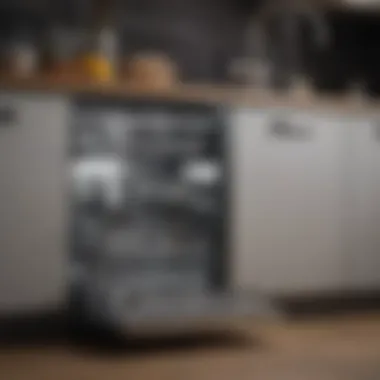How to Effectively Clean Grime from Your Dishwasher


Intro
Dishwashers serve as indispensable appliances in modern kitchens, streamlining our daily tasks. However, grime can accumulate over time, disrupt functionality, and affect the hygiene of the space. Understanding how to maintain and clean a dishwasher is crucial for its longevity and performance. This article will guide you through effective methods for removing grime, focusing on maintenance practices that ensure the appliance remains in optimal condition. By following these strategies, one can avoid common pitfalls and enhance both the efficiency and cleanliness of their kitchen environment.
Essential Cleaning Practices
Regular Maintenance
Maintaining a proper cleaning schedule is crucial to ensure that your dishwasher runs smoothly. Here are some key points to consider:
- Empty the Filter: The filter collects food particles. Cleaning it regularly helps to prevent clogs.
- Check the Spray Arms: Ensure they are free from blockages to allow for proper water flow during cycles.
- Wipe the Door and Seals: This area tends to gather grime and residue. Regular wiping maintains a clean surface and effective sealing.
Deep Cleaning Steps
For a thorough clean, follow these steps:
- Remove and Clean the Filter: Take out the filter and rinse it under warm water, using a soft brush if necessary.
- Descale with Vinegar: Place a cup of white vinegar on the top rack and run a hot water cycle. This helps to cut through grease and limescale.
- Baking Soda Rinse: After the vinegar cycle, sprinkle a cup of baking soda on the bottom and run another hot water cycle. This adds freshness and tackles odors.
- Inspect and Clean Drain: Ensure that the drain is free from clogs. Remove any visible debris.
"Regular maintenance not only prolongs the life of your dishwasher but also ensures optimal performance and hygiene."
Improving Dishwasher Performance
Best Practices for Loading
How you load your dishwasher can significantly impact its effectiveness. Here’s how to load it correctly:
- Avoid Overloading: Ensure that dishes are spaced out for optimal water circulation.
- Angle Items Downward: Position bowls and pots facing downward to allow proper drainage.
- Place Smaller Items in the Top Rack: This will prevent them from falling through gaps and ensure they get cleaned effectively.
Choosing the Right Detergent
It’s essential to select a detergent that aligns with your dishwasher’s capabilities. Some users prefer cascade pods, which dissolve effectively and often provide superior cleaning power. Others may opt for eco-friendly options to minimize environmental impact. Always refer to the manufacturer’s recommendations for best results.
Closure
Cleaning grime out of a dishwasher is not just about hygiene but also about sustaining the appliance's efficiency. By establishing a regular maintenance routine, understanding how to load and operate the appliance effectively, and choosing the right cleaning products, one can ensure that their dishwasher remains a reliable kitchen companion. Regular attention to these practices leads to significant benefits in dish cleanliness and machine longevity.
Implementing these straightforward techniques will make routine cleaning easier, keeping your kitchen functional and efficient.
Understanding Dishwasher Grime
Dishwashers are often overlooked when it comes to home maintenance. Yet, grime can build up in this appliance, leading to inefficiencies or unpleasant odors. Understanding the nature of dishwasher grime is essential for effective cleaning and ongoing maintenance. Knowing what grime consists of and how it accumulates can help users take proactive steps to ensure their dishwashers operate as intended.
Types of Grime
Grime in dishwashers can vary significantly based on the type of materials and substances involved. Common types include:
- Food Residues: This includes particles left over from meals, which can stick to dishes and the inside walls of the dishwasher. Common items are grease, starches, and proteins.
- Mineral Deposits: Hard water can leave behind limescale and mineral buildups. These can accumulate over time, affecting the dishwasher's performance.
- Soap Scum: This results from detergent interactions and can create a film on interior surfaces, leading to odors.
- Mildew and Mold: Damp environments in the dishwasher can promote mold growth, especially in seals and crevices.
By being aware of these types of grime, users can tailor their cleaning methods effectively.
Causes of Grime Build-Up
Several factors contribute to grime build-up in dishwashers. Understanding these causes can aid in preventing future occurrences.


- Improper Loading: Dishes not loaded properly can block spray arms. This prevents water from reaching all surfaces, leaving food residues behind.
- Leaving Food on Dishes: Rinsing dishes before placing them in the dishwasher can help reduce food particles, minimizing the growth of grime.
- Infrequent Cleaning: Neglecting regular cleaning can lead to the accumulation of residues and buildup.
- Water Quality: Areas with hard water create mineral deposits that build over time if not periodically addressed.
- Detergent Quality: Using poor-quality detergent may not remove grime effectively, leading to buildup.
Being mindful of these causes can help maintain a cleaner dishwasher. Regular maintenance checks can ensure that users avoid serious hygiene issues in their appliance.
Tools Required for Cleaning
Cleaning a dishwasher effectively requires appropriate tools and materials. The importance of this section lies in understanding how the right items can enhance the cleaning process. Utilizing the correct supplies not only simplifies the task but also improves results. A well-outfitted cleaning toolkit ensures that grime and residue are addressed thoroughly.
Essential Cleaning Supplies
Vinegar
Vinegar is renowned for its versatility in cleaning. This natural solution effectively breaks down mineral deposits and oily residues. Its acidic nature contributes to a thorough cleaning experience. Many choose vinegar due to its non-toxic profile, making it safe for various surfaces, including dishwasher interiors. Additionally, it is cost-effective and widely available. However, it should be noted that excessive amounts can leave a lingering scent if not rinsed properly, so moderation is advisable.
Baking Soda
Baking soda serves as a natural abrasive, making it invaluable in grime removal. It aids in neutralizing odors, which is crucial for maintaining a fresh appliance. Used alongside vinegar, it creates a fizzy reaction that can help dislodge stubborn stains. The gentle abrasive texture allows for effective scrubbing without damaging surfaces. Though it is generally safe for all dishwasher components, users should be cautious with soft plastics to prevent scratches.
Microfiber Cloths
Microfiber cloths are an essential supply for wiping down surfaces. Their unique fibers trap dirt and grime effectively, providing superior cleaning compared to regular cloths. They are highly absorbent and can be used dry or damp, making them versatile for cleaning tasks. Users appreciate that they can be reused and laundered, contributing to a sustainable approach. However, they should be kept separate from regular linens to avoid lint contamination, which can diminish their cleaning efficiency.
Optional Tools for Deeper Cleaning
When the standard cleaning tools are not sufficient, supplemental items can facilitate a more thorough approach. These tools help tackle difficult grime and ensure each area is addressed appropriately.
Old Toothbrush
An old toothbrush can be surprisingly useful for cleaning hard-to-reach areas. Its bristles allow for targeted scrubbing in crevices and corners where grime often accumulates. This tool is particularly beneficial for cleaning filter screens and spray arms. Individuals often prefer this method as it requires less aggressive scrubbing compared to harder brushes. Nonetheless, it is essential to clean the toothbrush thoroughly before use to avoid transferring bacteria.
Scraper
A scraper can aid in removing hardened grime from surfaces. This tool is effective in scraping off any accumulated residues without damaging the dishwasher interior. When selecting a scraper, it is essential to ensure it has a soft edge to avoid scratching surfaces. While it’s very effective, great care should be taken to use it gently to prevent any potential damage.
Mixing Bowl
A mixing bowl is practical for combining cleaning solutions, particularly vinegar and baking soda. This tool can help in preparing pastes or mixtures that may enhance cleaning effectiveness. It provides a dedicated space that allows for better control over the cleaning process. An essential consideration is using a bowl that is non-reactive to avoid any chemical reactions that could hinder cleaning efforts.
Preparing the Dishwasher
Preparing the dishwasher is a crucial step in the cleaning process. It sets the foundation for removing grime effectively. Before diving into the deep cleaning process, taking time to properly prepare can lead to better outcomes and ensure that your efforts are not wasted.
Empty the Dishwasher
The first and foremost task is to empty the dishwasher. This step is essential because it allows full access to all areas in the appliance. If dishes are left inside, it can hinder your ability to clean properly. Food debris can accumulate behind plates or bowls, leading to additional grime and odors. Furthermore, leaving dishes in can also interfere with the cleaning solutions you will apply.
Once you have removed all items, take a moment to inspect them for any food particles that may have stuck to them. A pre-rinse in the sink can be helpful before placing items back in the dishwasher after cleaning.
Check for Obstructions
After you have emptied the dishwasher, it’s important to check for obstructions. These obstructions can disrupt the cleaning process and may even lead to performance issues later on. Pay special attention to the spray arms. Ensure that there is nothing blocking their path. Sometimes, remnants of food or hard water deposits can cause these arms not to spin effectively.
Additionally, investigate the lower and upper compartments of your dishwasher. Look for stray utensils or items that may have fallen out of place. Furthermore, inspect the dishwasher filter for debris. If the filter is clogged, it can exacerbate grime issues in the future. Clear away any blocks you find and make note of anything that seems out of the ordinary.
"Taking time to prepare your dishwasher is not just about cleaning; it ensures its optimal performance for every load."


In summary, preparing the dishwasher is not merely a procedural formality. It is an integral process that increases the effectiveness of the cleaning methods you will apply. By emptying it thoroughly and checking for obstructions, you lay the groundwork for a successful cleaning operation.
Step-by-Step Cleaning Process
The Step-by-Step Cleaning Process is essential in understanding how to remove grime effectively from your dishwasher. This process not only improves cleanliness but also enhances the performance of your appliance. When followed methodically, each step addresses specific areas prone to dirt and staining. This systematic approach ensures no aspect of the dishwasher is overlooked, contributing to both hygiene and the longevity of the machine.
The benefits of having a well-conducted cleaning routine are plentiful. A clean dishwasher enables better performance, reducing the likelihood of unpleasant odors and ensuring that your dishes come out spotless. Additionally, regular cleaning can prevent mechanical issues and improve the lifespan of your appliance. Neglecting to attend to grime and stains can lead to larger problems down the line, such as decreased efficiency or more costly repairs.
Initial Rinse
The Initial Rinse is a straightforward yet significant step in the cleaning process. Rinsing your dishwasher before any detailed cleaning removes loose debris. This quick wash helps in dislodging particles that could otherwise contribute to grime build-up. It sets a cleaner stage for the subsequent steps. Simply run an empty cycle on the hottest setting. If your dishwasher has a specific rinse cycle, that may be utilized instead.
Cleaning the Filter
Next, focus on Cleaning the Filter. The filter is a critical component, as it traps food particles and grime. A clogged filter negatively impacts not only cleaning performance but also leads to foul odors. To clean it, locate the removable filter at the bottom of the dishwasher. Remove it and rinse it under warm water, using a soft brush for any stubborn bits. If you notice heavy discoloration or buildup, consider soaking it in soapy water before rinsing.
Wiping Down Interior Surfaces
After dealing with the filter, proceed to Wiping Down Interior Surfaces. Use a microfiber cloth dampened with warm soapy water or a vinegar solution to tap into those often neglected areas inside your dishwasher. Pay special attention to door seals and the walls. This step eliminates grease and further grime buildup, ensuring a hygienic environment for your dishware. Avoid abrasive materials that could scratch the interior surfaces.
Using Vinegar for Odors
Using Vinegar for Odors is an effective method worth exploring. Vinegar is a natural deodorizer and can neutralize unpleasant odors often found inside dishwashers. To implement this, pour a cup of vinegar into a dishwasher-safe bowl and place it on the top rack. Run an empty cycle on the hottest setting. This process not only freshens the machine but also helps to dissolve mineral deposits and grime lingering in hard-to-reach spots.
Applying Baking Soda for Stains
Finally, to tackle stubborn stains, consider Applying Baking Soda for Stains. After running a cycle with vinegar, sprinkle a cup of baking soda across the bottom of your dishwasher. Follow this with a short hot-water cycle to allow the baking soda to lift stains and freshen up any lingering odors. This dual-action approach with vinegar and baking soda can significantly enhance the overall cleanliness of the appliance.
By following these steps, one can achieve a clean and efficient dishwasher, contributing to better performance and hygiene in the kitchen.
Maintaining a Clean Dishwasher
Maintaining a clean dishwasher is crucial for ensuring the longevity and efficiency of the appliance. Regular upkeep prevents the build-up of grime, which can lead to persistent odors and reduced cleaning performance. A clean dishwasher not only functions better but also helps maintain hygiene in your kitchen. Understanding the importance of this maintenance practice can lead to more effective routines and less time spent on emergency cleaning.
Regular Cleaning Schedule
Establishing a regular cleaning schedule can drastically improve the condition of your dishwasher. Aim for a monthly cleaning to avoid major grime build-up. Here are some practical steps to include in your routine:
- Wipe Down Surfaces: After each use, take a moment to wipe the exterior and interior surfaces with a damp cloth. This helps remove spots before they become more entrenched.
- Clean the Filter: Every few weeks, check the filter and clean it as needed. A clogged filter can lead to poor performance and odors.
- Vinegar Maintenance: Once a month, run a cycle with a cup of vinegar placed in a dishwasher-safe cup. This acts as a natural deodorizer and helps dissolve grease and grime.
Creating a consistent schedule does not require a significant time investment but will pay off in improved appliance function and cleanliness.
Avoiding Common Mistakes
To maintain your dishwasher effectively, be aware of common mistakes that many users make. Here are some pitfalls to avoid:
- Ignoring the Filter: Some individuals tend to forget the importance of regular filter maintenance. Neglecting this component can lead to malfunctions.
- Overloading the Dishwasher: Stuffing the appliance beyond its capacity can block spray arms and prevent proper cleaning.
- Using Dish Soap: Using regular dish soap can create excessive suds, leading to leaks and residue build-up. Always use detergent specifically designated for dishwashers.
By being mindful of these issues, users can ensure their dishwashers stay clean and function efficiently for longer.
"Investing time in routine maintenance can save considerable effort down the line when it comes to cleaning stubborn grime and odors."
Troubleshooting Common Issues
Understanding the common issues that may arise with a dishwasher is crucial for maintaining its functionality and hygiene. Even after thorough cleaning, problems can occur. This section will discuss persistent odors and low cleaning performance—two prevalent issues that can compromise the effectiveness of your appliance. Addressing these concerns is not only about the appliance's efficiency but also about ensuring a clean and healthy kitchen environment.


Persistent Odors
Persistent odors in your dishwasher can stem from various sources. Food particles trapped in the filter, worn-out seals, or even stagnant water can contribute to unpleasant smells. Addressing this issue is essential for ensuring that your dishes do not come out with lingering scents.
To tackle persistent odors:
- Inspect the Drain and Filter: Start by checking the filter and the drain for trapped debris. Remove any food residues you find.
- Use Vinegar: Place a cup of white vinegar on the top rack of the empty dishwasher and run a hot cycle. Vinegar is effective in neutralizing odors.
- Check Door Seals: Inspect the rubber seals around the door. Food particles can become lodged in these seals. Cleaning them with a damp cloth can help.
If the problem persists after these steps, it may indicate a deeper seated issue within the dishwasher’s plumbing. Consider consulting a professional for further assistance, as they can help identify leaks or blockages that are not easily visible.
Low Cleaning Performance
A dishwasher's main function is to clean effectively, so low cleaning performance can be frustrating. This issue often manifests in dishes coming out still dirty or covered in spots.
Several factors may contribute to this problem:
- Clogged Spray Arms: If the spray arms are clogged, they cannot distribute water effectively. Remove and rinse the arms under hot water to clear any debris.
- Incorrect Loading: Dishwasher efficiency can decrease with improper loading. Ensure that dishes are not obstructing the spray arms or blocking water flow.
- Detergent Issues: Using the wrong type of detergent or expired products can impact cleaning performance. Make sure to use high-quality dishwasher detergent appropriate for your unit.
Regular maintenance checks can help prevent these issues. If problems continue even after following these tips, you may want to consider professional help to investigate any underlying mechanical problems.
When to Seek Professional Help
Maintaining a clean dishwasher is essential, but there are times when a deeper issue may arise that requires expert intervention. Seeking professional help can be a crucial step in ensuring the longevity and efficient operation of your appliance. Ignoring specific signs can lead to more significant problems, and understanding the indicators that suggest it may be time to consult a technician is vital. Let's explore two key aspects that help identify when to seek help.
Signs of Mechanical Issues
Recognizing mechanical issues in a dishwasher can save time and resources in the long term. Here are some common signs that indicate problems:
- Unusual Noises: If the dishwasher starts making strange sounds during operation, such as grinding or clanking, it might indicate something is wrong with the motor or the spray arms.
- Failure to Drain: A persistent problem with water remaining at the bottom after a cycle is a sign of drainage issues. This can indicate a blockage in the drain hose or a malfunctioning pump.
- Error Codes: Modern dishwashers often display error codes on the screen. Referencing the user manual can help determine the specific issue indicated by the code.
- Inconsistent Cleaning: If you notice that dishes are consistently coming out dirty after a cycle, it may point to issues with the spray arms, filter, or pump function.
If you notice any of these signs, it's wise to contact a professional repair service. They have the technical expertise to diagnose and resolve problems effectively.
Warranty Considerations
Understanding the terms of your warranty can guide your decision regarding professional repairs. Here are some aspects to consider:
- Coverage Details: Most dishwashers come with a manufacturer’s warranty that typically lasts from one to five years. It covers parts and, in some cases, labor for repairs. Review your warranty to understand what is covered.
- Service Provider Requirements: Many manufacturers require repairs to be carried out by authorized service providers. Using unauthorized services may void the warranty.
- Signs of Damage: If the dishwasher has damaged parts that might not fall under typical wear and tear, such as a dent or a crack, this may affect your warranty coverage. Check warranty documentation closely.
In any case, reaching out to a professional, especially if under warranty, can ensure that your dishwasher issues are addressed without incurring unnecessary costs.
Ending
Cleaning grime out of a dishwasher is not just about aesthetic appeal; it is vital for ensuring the appliance runs efficiently. Dishwashers often harbor residues that can affect their performance and the hygiene of your kitchen. Therefore, regular cleaning is essential.
Recap of Cleaning Methods
In summary, here are the key techniques to keep your dishwasher clean:
- Empty the Dishwasher: Always start with an empty unit to make the cleaning process more effective.
- Check the Filter: A clogged filter not only leads to grime but also impacts cleaning efficiency. Make sure to clean it regularly.
- Use Vinegar and Baking Soda: These natural cleaners can help to eliminate odors and stains effectively.
- Wipe Down Interior Surfaces: A microfiber cloth is ideal to tackle the interior surfaces, ensuring a residue-free finish.
- Establish a Regular Cleaning Routine: Setting a schedule for cleaning will help maintain the efficiency of your dishwasher.
By following these steps regularly, the longevity and performance of your appliance can be greatly enhanced.
Final Thoughts on Maintenance
Dishwasher maintenance goes beyond just the cleaning process. Proper usage, load management, and regular assessments of the appliance's condition play crucial roles.
Make sure you:
- Avoid Overloading: This can lead to inefficiency and grime accumulation.
- Select Appropriate Cycles: Use the right settings based on the type of your load, which can help minimize stains.
- Monitor Seals and Gaskets: Regular checks can prevent leaks and retain efficiency.
By incorporating these maintenance habits, you ensure that your dishwasher remains in good working condition, providing your kitchen with the hygiene and convenience it requires.



